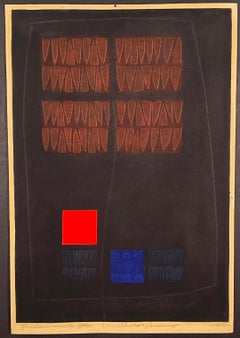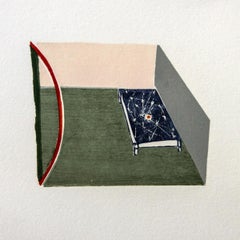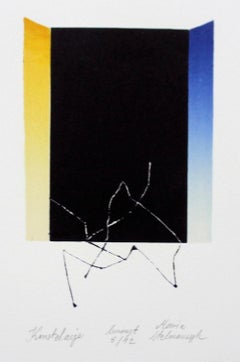Kunihiro Amano Prints and Multiples
to
1
Overall Width
to
Overall Height
to
1
1,183
939
885
817
1
1
1
1
Artist: Kunihiro Amano
ENCLOSURE 12
By Kunihiro Amano
Located in Portland, ME
Amano, Kunihiro (Japanese, born 1929). ENCLOSURE 12. Color Woodblock, not dated. Edition of 30. Titled, Numbered 21/30, and signed in pencil. 18 x 13 1/2 inches. In excellent condit...
Category
Mid-20th Century Kunihiro Amano Prints and Multiples
Materials
Woodcut
Related Items
Room with a red arch - XXI Century, Contemporary Linocut Woodcut Print, Colorful
By Maria Stelmaszczyk
Located in Warsaw, PL
Maria Stelmaszczyk is a Polish artist born in 1983.
PROVENANCE
Exhibited at Katarzyna Napiorkowska Gallery.
The Gallery is a primary representative for this artist.
The Gallery o...
Category
Early 2000s Contemporary Kunihiro Amano Prints and Multiples
Materials
Paper, Woodcut, Linocut
$161 Sale Price
20% Off
H 3.55 in W 4.73 in
Constellation - XXI Century, Contemporary Linocut & Woodcut Print, Abstract
By Maria Stelmaszczyk
Located in Warsaw, PL
MARIA STELMASZCZYK (born in 1983) Studies at the Faculty of Graphic Arts and Painting
Laboratory of Woodcut Techniques and Artistic Book at the Academy of Fine Arts Władysław Strzemi...
Category
Early 2000s Contemporary Kunihiro Amano Prints and Multiples
Materials
Paper, Linocut, Woodcut
$161 Sale Price
20% Off
H 5.52 in W 3.55 in
Untitled
By Kiki Smith
Located in New York, NY
Kiki Smith
'Untitled,' 1995
Woodcut with color additions by hand
31 x 21 inches
Edition 43 of 47
Signed
In 1995 five well-known American artists - Donald Baechler, Julian Lethbridge...
Category
1990s Kunihiro Amano Prints and Multiples
Materials
Woodcut
Bernard Lorjou "Pirouette au Galop" 1978 Expressionist Woodcut, Signed, H.C. Edn
By Bernard Lorjou
Located in Miami, FL
BERNARD LORJOU – "PIROUETTE AU GALOP"
⚜ Woodcut ⚜ Hand Signed Lower Left ⚜ Numbered H.C. from the Edition of 80 ⚜ Conservation Frame
ENERGY AND DRAMA FROM “LE CIRQUE”
Created in 197...
Category
1970s Expressionist Kunihiro Amano Prints and Multiples
Materials
Woodcut
Bernard LorjouBernard Lorjou "Pirouette au Galop" 1978 Expressionist Woodcut, Signed, H.C. Edn, 1978
$2,600 Sale Price
35% Off
H 28 in W 33.5 in D 1 in
Coleman Pond III
By Alex Katz
Located in Miami, FL
Alex Katz (b. 1927)
Coleman Pond III (Bauer 446)
Heliorelief woodcut on tosa washi hanga natural paper
Signed and numbered “Pres 1/6” in the lower margin. Printed by Tom Pruitt, G...
Category
21st Century and Contemporary Abstract Kunihiro Amano Prints and Multiples
Materials
Etching, Woodcut
Norcamphor from “40 Woodcut Spots"
By Damien Hirst
Located in Calabasas, CA
Artist: Damien Hirst
Title: Norcamphor from “40 Woodcut Spots"
Year: 2011
Medium: Woodcut on 410gsm Somerset White Paper
Edition: 43/55; signed (recto) and numbered (verso) in penci...
Category
2010s Contemporary Kunihiro Amano Prints and Multiples
Materials
Woodcut
Set of three woodcuts by Victor Mira colorful abstract forms
Located in New York, NY
These lively, colorful works are full of movement and Mira's characteristic mysterious, mythical figures and shapes.
Victor Mira
Set of three woodcuts on buff, textured paper, 1983...
Category
1980s Abstract Kunihiro Amano Prints and Multiples
Materials
Woodcut
A fig - Contemporary Linocut Woodcut Print, Geometric
By Maria Stelmaszczyk
Located in Warsaw, PL
MARIA STELMASZCZYK (born in 1983) Studies at the Faculty of Graphic Arts and Painting
Laboratory of Woodcut Techniques and Artistic Book at the Academy of Fine Arts Władysław Strzemi...
Category
Early 2000s Contemporary Kunihiro Amano Prints and Multiples
Materials
Paper, Linocut, Woodcut
$161 Sale Price
20% Off
H 3.35 in W 4.93 in
Asymmetric composition. Woodcut & Linocut, Op art, Abstract Print, Polish art
By Ryszard Gieryszewski
Located in Warsaw, PL
Contemporary op art abstract linocut and woodcut print by Polish artist Ryszard Gieryszewski. Print is mostly black&white with addition of blue and red. Title of this artwork is 'Asy...
Category
Early 2000s Abstract Kunihiro Amano Prints and Multiples
Materials
Paper, Linocut, Woodcut
$711 Sale Price
20% Off
H 24.81 in W 16.93 in
Orange labyrinth - XXI Century, Contemporary Linocut & Woodcut Print, Abstract
By Maria Stelmaszczyk
Located in Warsaw, PL
MARIA STELMASZCZYK (born in 1983) Studies at the Faculty of Graphic Arts and Painting
Laboratory of Woodcut Techniques and Artistic Book at the Academy of Fine Arts Władysław Strzemi...
Category
Early 2000s Contemporary Kunihiro Amano Prints and Multiples
Materials
Paper, Linocut, Woodcut
$161 Sale Price
20% Off
H 5.52 in W 3.55 in
Charles Arnoldi 'Macchu Picchu 4' Limited Edition, Abstract Signed Print
By Charles Arnoldi
Located in San Rafael, CA
Charles Arthur Arnoldi (b. 1946)
Macchu Picchu 4, 2019
Woodcut in colors on wove paper
Edition: 25/30
Signed, editioned, and dated in pencil along lower edge
Printed by Peter Kosowicz, Thumbprint Editions, London
Published by Harvey Bayer...
Category
21st Century and Contemporary Abstract Geometric Kunihiro Amano Prints and Multiples
Materials
Woodcut
$1,800
H 30.25 in W 21 in D 0.02 in
La Peche lithograph (woodcut)
By Raoul Dufy
Located in Belgrade, MT
Raoul Dufy was an important multifaceted French artist who worked in a variety of media including painting, print making, mural design, theatre and costume design, upholstery, wall paper, ceramics, and fabric. In his paintings he often depicted the circus, equestrian scenes, Parisian cafe life, yachting scenes, colorful views of the French Riviera, and musical events in a distinctive style that combined the various artistic trends of the day, most notably Fauvism. Born in 1877 in Le Havre France, and after a year of military service in 1900, Dufy won a scholarship to the Ecole Nationale superieure des Beaux-Arts, in Paris, studying under Othon Friesz. He exhibited extensively throughout Paris and France at the various salons, including the Salon des Tuileries. For the 1937 Exposition Internationale in Paris, Dufy completed one of the largest paintings ever conceived, a 250...
Category
Early 20th Century Fauvist Kunihiro Amano Prints and Multiples
Materials
Lithograph, Woodcut
Kunihiro Amano prints and multiples for sale on 1stDibs.
Find a wide variety of authentic Kunihiro Amano prints and multiples available for sale on 1stDibs. If you’re browsing the collection of prints and multiples to introduce a pop of color in a neutral corner of your living room or bedroom, you can find work that includes elements of red and other colors. You can also browse by medium to find art by Kunihiro Amano in woodcut print and more. Not every interior allows for large Kunihiro Amano prints and multiples, so small editions measuring 20 inches across are available. Customers who are interested in this artist might also find the work of Katsunori Hamanishi, Shigeru Taniguchi, and Risaburo Kimura. Kunihiro Amano prints and multiples prices can differ depending upon medium, time period and other attributes. On 1stDibs, the price for these items starts at $1,200 and tops out at $1,200, while the average work can sell for $1,200.


